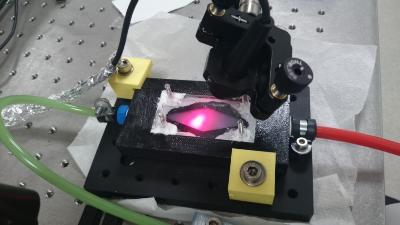Alexandra Alexandrova to present latest results at SPIE Photonics Europe
Alex is going to present the results of her work at the SPIE Photonics Europe conference in Brussels, Belgium in 14-17 April. The poster is entitled “Self-mixing Diode Laser Interferometry for Velocity Measurements of Different Targets.”

Gas targets are used for a number of accelerator based experiments as well as for beam diagnostic purposes. In the case of supersonic gas jets, they combine low internal temperatures with high directionality and as a result they are very interesting as experimental targets in different fields of science. For the optimisation and verification of the properties of such a monitor the gas jet needs to be characterised with high accuracy, in particular with regards to its velocity and density profile. In these applications, gas jet velocities can be up to 2,000 m/s with inhomogeneous distribution across the jet. However, all currently used methods for such characterisation are either not reliable or require a powerful laser system.
A diode laser velocimeter based on the laser self-mixing method is currently being developed by the QUASAR Group as an easy-to-build and compact solution when compared to alternative measurement techniques. The technique has the potential for complete characterisation of the gas jet parameters. The laser velocimeter could provide detailed information about the velocity, density and temperature of any jet with micrometer-resolution. Such a sensor would allow for unambiguous measurements from a single interferometric channel and could be installed even in radiation-exposed environments.
In the SPIE contribution, the heterodyne principle and design of the laser diode velocimeter will be discussed. The laser velocimeter is a self-aligning device, based on the self-mixing method where the laser is both a transmitter and receiver of the signal. It should be pointed out that laser self-mixing is usually used for measurements of low velocities and vibrations. The theoretical analysis to be presented shows the possibility of also extending these measurement capabilities to high velocities by altering the design.
Experimental results from measurements with different targets, including white paper and fluids will be presented. The initial calibration and verification of the accuracy of the method showed that the velocity of a white paper target can be measured with an accuracy better than 2% and micrometer spatial resolution over a velocity range from 0.5 mm/s to 50 m/s. The set-up for testing the sensor allowed investigations into the limitation of the method as well as into the amount of feedback which is needed for a detailed study of a gas jet. In order to verify the possibility of using the velocimeter as a flow sensor, measurements of local velocities were performed on fluids with externally-imposed flow profiles. The sensor’s capability to measure higher target velocities is also discussed.